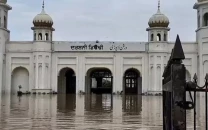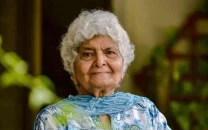2011
If 2012 is anything like 2011 was for Pakistan, the end of the world may come as a welcome respite.

The year began with murder. The flamboyant and outspoken governor of Punjab, Salmaan Taseer, was gunned down in broad daylight on January 4 in Islamabad’s Kohsar market by Mumtaz Qadri, a member of the Elite police force tasked with his protection.
A strong opponent of the blasphemy law, the governor had incurred the ire of extremists for his defence of a Christian woman convicted of blasphemy. This was the reason his murderer gave to justify the killing of Salmaan Taseer. What followed was no less tragic.
While parliament passed resolutions condemning the assassination and civil society activists organised a vigil in Taseer’s honour, more people lauded the murderer and celebrated his crime, burning tyres and blocking traffic in Lahore and Multan. As many as 500 Islamic scholars belonging to the Barelvi school of thought condemned the slain politician for his defence of Aasia Bibi, who is currently on death row.
Clerics even called for a boycott of Taseer’s funeral, and the chief cleric of the Badshahi Mosque, who had agreed to offer the funeral prayers, excused himself at the last moment by saying he was going out of town. Eventually Muhammad Afzal Chishti, the secretary general of the Pakistan Peoples Party (PPP) Ulema wing had to lead the prayers, which were conducted under strict security.
Qadri made his first appearance in an Islamabad court on January 10, where he was showered with petals by admirers amidst chants of “God is Great!” YouTube videos of Mumtaz Qadri contained more messages of support for his actions than condemnation, and Facebook fan pages were set up in his favour.
On October 1, the anti-terrorism court in the Adiyala Jail, Rawalpindi, found Mumtaz Qadri guilty of murdering Salman Taseer and sentenced him to death penalty, a verdict that was once more met with protests from the religious right. Even Justice Pervaiz Ali Shah, the judge who delivered the verdict, was forced to flee the country after threats from extremists.
While Qadri’s sentence is yet to be carried out, the Sunni Ittehad Council — a group of Barelvi parties — gears up to celebrate January 4 as Mumtaz Qadri Day, and are seeking a presidential pardon for him. Meanwhile the travails of the Taseer family seem never-ending. Nearly seven months after the assassination of his father, 27-year-old Shahbaz Taseer was abducted at a busy intersection in Lahore on August 26. Despite Punjab Law Minister Rana Sanaullah’s recent hint that the abduction case will soon be resolved, Shahbaz Taseer still remains missing.
Raymond Davis
It’s not often that you get to see a real-life spy drama unfold before your eyes, but that’s exactly what happened with the Raymond Davis affair. On January 27, 2011, US citizen Raymond Davis shot dead two men in a market area in Lahore, gunning them down with his glock pistol with the precision of an expert. Davis, who was driving a rented car with local plates, was arrested before he could get away from the scene, and an abortive attempt to rescue him by a US consulate vehicle left another man dead in a hit and run.
Raymond was taken into custody by the Punjab police, who also recovered phones and a GPS device from him. The charge sheet filed by the city police declared that Davis was prima facie guilty of double murder and had in fact tried to cheat investigators by concealing information.
There were allegations, later proved correct, that Davis was a member of US special forces and had also worked with the notorious security firm Blackwater. Investigations by the US media revealed that Hyperion Protective Services, the company Davis claimed to be an employee of, existed only as a website. The offices that the company says it has in Orlando have been vacant for several years and the numbers on its website are unlisted.
Pressure was heaped on the Pakistani government from all quarters of the US government, who remained adamant that Davis was in fact a diplomat and entitled to diplomatic immunity. US president Barack Obama called for his release and members of Congress even threatened an aid cut-off if he was not freed. Meanwhile, the mood in Pakistan soured dramatically. Rallies were taken out calling for Davis’ execution and politicians of all stripes jumped into the fray, demanding justice for his victims. The controversy was compounded by tragedy when Shumaila, the wife of one of Davis’ victims committed suicide by taking poison. Her last words were an appeal for justice and revenge.
However, the affair came to an unexpected end on March 16, when Davis was acquitted of two counts of murder and released after Rs200 million Diyat (blood money) was paid to the families of the victims.
Then foreign minister Shah Mahmood Qureshi was also apparently a victim of the Davis affair. Deprived of the FM slot after a cabinet reshuffle, Qureishi implied that his stance that Davis did not enjoy diplomatic immunity cost him his job. In a rally at Ghotki on November 27, Qureishi repeated this claim.
Meanwhile, back in the US, Davis found himself in trouble again when he punched a man in after a dispute over a parking space in Colorado.
Shahbaz Bhatti
The nation had barely come to terms with the killing of Salmaan Taseer when another high-profile murder took place. Shahbaz Bhatti, the first Federal Minister for Minorities Affairs, was killed on the morning of March 2 as he was driving from his mother’s house. Assailants dressed in shalwar kurtas stopped his car and first took his driver out of the car and then shot 25 bullets at Bhatti. Bhatti, a Roman Catholic, was a vociferous critic of the blasphemy laws and supported Aasia Bibi, a Pakistani Christian sentenced to death in 2010 for blasphemy. He had also campaigned for Pakistani Christians attacked in the 2009 Gojra riots in Punjab.
When questions were raised about the level of security provided to Bhatti, especially in the wake of the assassination of Salmaan Taseer, the IG Islamabad Wajid Durrani said it was the minister’s instructions to keep the security detail at the office. Bhatti himself once commented that “Protection can come only from heaven, so these bodyguards can’t save you.”
On the day following the assassination, hundreds of Christian demonstrators took to the streets across Punjab, burning tyres and demanding justice. The Vatican, along with many world leaders, condemned the murder while the government made the usual statements about fighting terrorism.
The Tehreek-i-Taliban claimed responsibility for the murder, labelling Bhatti a “blasphemer”. Witnesses present at the crime scene revealed that leaflets were scattered around the place which read, “This is the punishment of this cursed man.” None of this prevented Asadullah Bhutto, the chief of Jamaat-e-Islami Pakistan, Sindh chapter from blaming the CIA for the killing, claiming it was at attempt to distract the masses from the Raymond Davis case. No breakthroughs have been made in the case thus far.
PNS Mehran
Who will defend the defenders? That was the question on the minds of most Pakistanis when the attack on the PNS Mehran base in Karachi unfolded on May 22.
The 17-hour gunbattle left at least 12 security personnel dead, including navy soldiers, commandoes and rangers personnel. Two PC-3 Orion aircraft and a helicopter were also destroyed, seriously damaging the Navy’s capabilities.
Although according to the First Information Report there were more than 10 attackers, the bodies of only four terrorists were found inside the naval airbase and these remain unclaimed at the Edhi morgue.Unofficially, the search for the fugitive terrorists continues.
Immediately after the attack, Interior minister Rehman Malik provided a touch of farce, referring to the assailants, who were kitted out for special operations, as being “dressed like Star Wars characters.”
The attack rattled the navy so much that it was forced to send an entire fleet of warships away from Karachi to its base in Ormara, Balochistan in the aftermath of the incident.
The Taliban’s early claim of responsibility did not end speculation as to the origin and motivation of the attackers. A few days later Nawaz Sharif accused ‘anti-state forces, including the US, of carrying out the attack.
Initially, there was speculation that the PNS Mehran attack was in retaliation to the May 2 Abbottabad raid in which OBL was killed. Asian Times Online’s investigative journalist Saleem Shahzad claimed in an article that al Qaeda was behind the attack, but he said the issue was not the OBL raid. He claimed that al Qaeda had infiltrated the rank and file of the navy, and some members had been held by naval intelligence which al Qaeda wanted released. He claimed that it was in this connection that two navy buses were also attacked on April 26 and April 28, leaving at least a dozen navy personnel dead. A week later, Shahzad was murdered under mysterious circumstances on May 30.
Following disclosures that the attackers had entered using only a ladder and wire-cutters, the base commander was removed and a report on the attack was submitted to the prime minister in June. On August 3, it emerged that the former PNS Mehran base commander Commodore Raja Tahir and two of his subordinates — one captain and one commander — were to face trial before a court martial.
In December, a woman, said to be the wife of a Punjabi Taliban terrorist Qari Shahid, confessed that her slain husband had a role in the attacks. However, the inquiry report into the high profile case has not been made public to date.
Target Killings
This was the year Karachi’s streets ran with blood as they never have before. The highest recorded number of target killings since 1996 brought Pakistan’s largest city to its knees. The descent into madness began in January when Wali Khan Babar, a Pakistani journalist, fell prey to a volley of bullets and intensified in March when approximately 158 people were killed in a span of just 22 days. April marked the death of Safdar Ali Kiyani, Pro-Vice-Chancellor of the University of Balochistan, and as many as 23 others, which finally forced Prime Minister Yousaf Raza Gilani to take notice of the issue. Unsurprisingly, statements and high-level meetings failed to stop the killings, and as many as a hundred people were killed in July during a five day period. Some headway was made in August with the arrest and confession of alleged target killer Muhammad Ishtiaq but the violence continued, claiming the life of Sardar Rustam Jamali, the Excise and Taxation Minister of Balochistan.
As people were killed mercilessly, it became increasingly clear that targets were being selected on political, sectarian and ethnic bases. While accusations were traded and threats were made, no one — from the government to local leaders — seemed to accept responsibility for the continuing violence or showed any ability or desire to control it. Political parties and groups simply traded accusations as the death toll mounted. Reports and videos of horrific torture and murder also began to circulate, adding a new dimension to the terror faced by residents of Karachi.
While Karachi was being attacked by an army of assassins, the only reassuring words Interior Minister Rehman Malik had to offer over the months were: ‘effective measures are being taken’, ‘people have been arrested’, ‘surveillance planes have been ordered’ and ‘a peaceful environment shall be restored in the city’. In an interview with Indian Express reporters, he even blamed disgruntled wives and girlfriends for 70 percent of the target killings.
According to statistics compiled by the Human Rights Commission of Pakistan, 987 people were killed during January 2011 to October 2011. Arrests have been made and raids have been conducted, but Karachiites fear that it will only take a small spark to start the cycle of murder all over again.
Osama bin Laden
The manhunt that began in Tora Bora in 2001, ended in Abbotabad in 2011. On May 2, US special forces flew across the Pak-Afghan border in specially modified stealth helicopters and attacked the compound in which Osama was hiding. Within hours, the al Qaeda leader was apparently shot dead and his body disposed of in the Arabian Sea.
Operation Neptune Spear (also known as the Abbottabad operation) unleashed a Pandora’s Box of controversies for Pakistan. Bin Laden’s damning presence in the garrison town of Abbottabad was evidence enough to suspect that Pakistani security agencies were either incompetent or complicit in sheltering the world’s most wanted man. And thus, a decade into Pakistan’s fight against burgeoning militancy, the world was given a great reason to doubt the country’s commitment to the war against terrorism.
As Pakistan’s military-intelligence nexus came under fire after the US raid, at home and abroad a deluge of nagging questions and conspiracy theories followed suit. How did Osama’s presence go undetected? Were the Pakistani military and intelligence agencies actually sheltering him? And if so, why? Why was Osama’s body disposed of so quickly? Were the Pakistani authorities aware of the impending raid?
In an unprecedented move, the country’s beleaguered establishment decided to give an explanation to parliament. On May 13, the Director General Inter-Services Intelligence General Shuja Pasha appeared before an in-camera national assembly session to answer some of these questions. Despite the uproar, no military personnel have been offered for accountability, and none have deigned to resign as a result of the fiasco.
Instead, military authorities vociferously denied claims of complicity and incompetence. They told the parliament that the US used stealth technology to enter into Pakistani territory and their helicopters made their way deep inside the country without being detected by the country’s radar system. In the same session, the parliamentarians decided to form an independent commission to probe into the matter.
And this particular inquiry has not been languishing in the backdrop of the country’s chaotic politics; in fact the Abbottabad commission has already summoned politicians and high-ranking military officials—the DG military operations and DG ISI — for questioning.
However, the focus of attention seems to have shifted from the implications of Osama’s presence In Pakistan to the more nebulous question of Pakistan’s sovereignty being violated by the US raid.
Apart from Osama himself, the other major casualties of the raid have been Pakistan’s credibility and its standing with the US.
Dengue
What target killings were for Karachi, dengue was for Lahore. Punjab took the brunt of the dengue epidemic in 2011, with as many as 31,655 people succumbing to the bite of the Aedes Aegypticus and contracting the virus. Of those infected, 347 died, with 296 deaths occurring in Lahore alone. Sindh got off relatively lightly, with 1,053 infected and 17 deaths.
After the previous outbreaks, one would have assumed that the government would be better prepared to deal with the problem in 2011. Sadly, this was not the case. Apart from some efforts at fumigation, most of the measures taken were reactive in nature, with the government only going into overdrive when the extent of the epidemic became known.
While the Punjab CM Shahbaz Sharif rolled up (or down as the case may be) his sleeves to battle the epidemic, it often seemed that the virus was more than he could deal with.
Decisions were taken to shut down all educational institutes for 10 days in Lahore and later fixed school timings of 9am to 3pm were established. Schools also instructed students to wear long sleeves and trousers. Health institutes were directed to secure the necessary medicines from neighbouring India, administrative rooms in government hospitals were converted into wards for dengue patients and entire cities and towns were blanketed with awareness posters and pamphlets. Section 144 was used in Lahore to ban the washing of cars in the streets and establish a fixed charge of Rs90 for a Complete Blood Count (CBC) test. The formation of a separate ‘environmental police’ was also proposed by the CM, and compensation of of Rs500,000 for the families of the dengue victims was also announced. Additionally, the Punjab government requested the WHO to send a team to assess the situation on ground and provide support, and invited Sri Lankan doctors to come and help with training and solutions.
None of the measures stopped dengue panic though, and the sales of mosquito repellents and bug zappers sky-rocketed. Herbal cures proliferated and mazaars were packed with supplicants seeking divine protection from the virus. Unsurprisingly, quacks and charlatans had a field day. Ultimately, the epidemic wound down largely due to winter’s arrival. However, it’ll be back again in 2012 and we should be better prepared by then, given that 110 doctors, nurses, epidemiologists and entomologists have left for Thailand for training.
Floods
As if suicide bombings, target killings, drone attacks and the dengue epidemic were not enough, floods also took a terrible toll on Pakistan this year. Incessant monsoon rains caused flooding in August and September as vast areas of cultivable land were left submerged under water. The natural calamity affected over 5 million people; 4.82 million people in Sindh and over 300,000 people in Balochistan, according to the recently completed joint UN-Government Multi-Sectoral Needs Assessment (MSNA).
More than 200 people died, approximately 4.2 million acres of land was destroyed, close to 1.8 million people were displaced and close to 800,000 homes were washed away, while the government sat back strategising about how best to mobilise relief supplies to the flood affected areas. Initially, the Sindh government declared it needed no foreign aid and that its own resources were sufficient, but that claim very quickly proved premature. In any eventuality, little or no timely aid actually made it to the people who needed it the most.
As the government deliberated over how much it should aim to collect in international aid, people sat under the open sky, their homes destroyed, trying to keep their hopes high while fighting hunger pangs and disease.
The Peoples Accountability Commission on Floods (PACF), a network of flood-affected communities, volunteers and humanitarian activists, released a report in November blaming the National Disaster Management Authority for mismanagement and irregularities in the relief process.
The fact that this year’s floods were smaller than last year’s did not mean that the government was prepared any better. Quite apart from the human suffering, the devastation wreaked has had far-reaching implications, a fall in exports and a spike in inflation being a few.
Zulfiqar Mirza
Move over Julian Assange, 2011 was the year of the Zulfileaks. Pakistanis were glued to their TV sets on 28th August, as former Sindh home minister Zulfiqar Mirza let it all hang out...with a Quran on his head. Mirza accused the MQM and its leader Altaf Hussain of committing mass murder, supporting terrorism and even conspiring to break apart Pakistan in line with a ‘secret American plot’. Governor Sindh Ishratul Ebad also found himself at the receiving end, as Mirza accused him of intervening to free notorious target killers and of allowing other killers to operate their networks from behind bars. Interior MInister Rehman Malik also had more than a few verbal broadsides directed at him, and was accused of being a compulsive liar, and one of the main reasons peace had not been restored in Karachi. Malik was also accused of being insincere to the PPP and the country. Mirza also announced his resignation from the Sindh assembly as well as from his post of vice president of PPP’s Sindh chapter at the same press conference.
Following the explosive press conference, the MQM staged protests against Mirza, called upon the PPP to take action against him and also staged their own counter press-conference, accusing Mirza of supporting the People’s Aman Committee and the MQM-H. The MQM also tried — unsuccessfully — to implicate Mirza in a blasphemy case.
Mirza later also blasted the current Sindh Home Minister, Manzoor Wassan, calling him an idiot. He referred to Sindh CM Qaim Ali Shah as a “bechara” in a TV show, in which he also said things about Altaf Hussain that were...well...uncharitable. The one person Mirza has been careful not to criticise is President Asif Ali Zardari.
Mirza’s outbursts have also led to fears of potential cracks in the Sindh PPP itself, and there have been clashes between his supporters and those of Manzoor Wassan’s in Badin. Mirza claims that many PPP workers and leaders have offered him their support, albeit in private. Supporting Mirza publically seems to be a bad idea for PPP leaders, as former information minister Sharjeel Memon found to his dismay. Having accompanied Mirza to London, Memon was forced to resign on his return to Pakistan.
With the support of Lord Nazir, he has vowed to present evidence against the MQM in the house of Lords. Even in London, though, he has been dogged with trouble with altercations between him and MQM supporters at a press conference.
Veena Malik
When we needed a break from all the Osamas, Memos and Haqqanis of the world, it was Veena Malik to the rescue! When the Bigg Boss controversy hit the headlines, Veena gave the proverbial verbal smack down to our very own Kamran Shahid and Mufti Abdul Qavi. Suddenly, “Mufti sahib, yeh kya baat hui” was on everyone’s lips.
A few days later, Veena was back, this time to announce her break up with her fiancé, Faisal Akbar Khan, which immediately set tongues wagging about the Ashmit-Veena connection. But the actor clarified that she and Patel were just good friends.
May brought traumatic news to Veena-fans when she suffered injuries in a car crash while travelling from Islamabad to Lahore. Thankfully the actress had recovered by July to promote her upcoming debut in her first Bollywood film Daal Mein Kuchh Kaala Hai.
Veena Malik was back in the news in October, after becoming the sponsor mother of Payal Kamble, a seven-year-old girl living with the Sahaara Charitable Society in India and November brought with it news of Veena’s upcoming reality television show, “Swayamvar”. Would Veena get married on-screen and take home INR30 million or would she walk away, netting herself INR15 million?
Capping off the year, Veena pulled a Kardashian and appeared nude on the cover of FHM India, with ISI stencilled on her arm. Stirring controversy on both sides of the border, Veena claimed that the she was merely topless in the photo shoot and that the picture was morphed. Veena sued FHM India, who countersued, claiming that Veena had willingly participated in the photo shoot and was, in fact, actually naked and that the photos were not altered in any way.
Some have praised her as a feminist icon and others have condemned her as the spawn of Satan. But Veena Malik is, at the end of the day, Veena Malik. And that’s enough.
Memogate
No incident highlighted the continual mistrust between the civilian and military authorities this year like the Memogate scandal.
On October 10, Pakistani-American businessman Mansoor Ijaz wrote an op-ed in London’s Financial Times, alleging that Pakistan’s ambassador to the US Hussain Haqqani had asked him to pass on a memo to the then-chief of US military, Admiral Mike Mullen after the raid in Abbottabad on May 2. The note highlighted the supposed threat of a coup that the civilian government faced after bin Laden’s killing and sought American assistance in redressing the civil-military imbalance in Pakistan. Ijaz’s evidence for corroborating his allegations were a series of Blackberry transcripts and telephone records.
The issue caused an uproar in Pakistan, and as Haqqani was summoned back to Pakistan, ISI chief Shuja Pasha jetted off to meet Ijaz. Subsequently, Haqqani resigned from his position and was quickly replaced by former information minister Sherry Rehman. But his resignation hardly resolved the matter.
On November 29, Prime Minister Gillani referred to the parliamentary committee for national security for a probe into the affair. Yet, this was one issue that was not going to be simply relegated to the files of a government-led investigation.
PML-N chief Nawaz Sharif petitioned the court to investigate the case on December 1 and a nine-member special bench of the Supreme Court ordered the formation of a commission to investigate the matter.
But even before the Supreme Court was scheduled to hear the petition formally, the government, which calls memogate a ‘non-issue’ protested against the initiation of the investigation, claiming that the parliamentary committee had the rightful mandate for the particular task.
Yet this did not stop the SC from going ahead with the proceedings., After the initial hearing of the memogate petition, it gave respondents—including the President, the COAS, the DG ISI and former ambassador Husain Haqqani— 15 days to file their replies to the petition.
Haqqani submitted his reply on December 9, and Ijaz submitted his reply to the SC on December 15th. In his 81-page statement, the businessman confirmed his meeting with Inter-Services Intelligence Director Lt General Shuja Pasha in London on Oct 22, where he allegedly showed the spy chief proof of the existence of the memo.
The DG ISI Pasha and COAS General Ashfaq Kayani have also submitted replies to the SC. The army chief in his affidavit said that the memo was a reality and should be investigated thoroughly. On December 17, General (retd) James Jones, former US national security adviser who allegedly handed the memo to Mullen, submitted his reply.
In its reply to the SC, relayed in the form of an affidavit, the federal government declared that Shuja Pasha stepped beyond his jurisdiction when he briefed Chief of Army Staff (COAS) Ashfaq Pervez Kayani about his meeting with Mansoor Ijaz in London.
However, the President has not yet filed a reply to the memogate scandal. This is one issue that will continue to reverberate well into 2012.
Salala attack
Just when we thought that Pakistan and the US had had their fair share of bickering for 2011, along came another cause of contention. On November 26, NATO helicopters attacked a Pakistani check post in Salala, located in the Mohmand Agency on the Pak-Afghan border, killing 24 soldiers and injuring 12.
And thus began another series of accusations and denials, which have become the defining characteristic of US-Pak relations. Only this time, Pakistan was hurling accusations and the US was denying.
The government, political parties and the military were united in condemning the attack and the Director General Military Operations (DGMO) Major General Ashfaq Nadeem went so far as to call the attack deliberate.
However, the US insists that the strike was actually intended to target militants and was just an accident. That explanation wasn’t enough for Pakistan, and the government decided to play it tough. Apart from boycotting the Bonn conference, Pakistan ordered the US to vacate the Shamsi airbase, and NATO supplies transiting Pakistan for Afghanistan were blocked.
On December 17, senior Pakistani officials made their presentation in Washington, claiming that November 26 could not have been an error in judgment.
On December 22, a US probe found both American and Pakistani forces responsible for the attack due to inadequate coordination between military officers from both sides. Pakistan rejected the report, with the military calling it “short of facts” and saying that it would give a response when it receives a detailed report.
SPORTS
Mowed down in Mohali
To call the build-up to the March 30 Pakistan vs India showdown at the ICC Cricket Worldcup 2011 Semi Finals ‘huge’ would be like calling World War II a skirmish. Politics, security issues and cross-border tension were all part and parcel of the ultimate cricketing showdown. India struggled to reach the semi-final but in the end they rose to the occasion against the ever unpredictable Pakistan squad. Despite the brilliant efforts of Wahab Riaz, who claimed five wickets, Pakistan lost by 29 runs, largely as a result of numerous dropped catches.
Shamed by spotfixing
Losing to India in the World Cup wasn’t the only blow suffered by Pakistani cricket in 2011. This was also the year in which three Pakistani cricketers were convicted for their role in the spot-fixing scandal. On November 3, 2011, the Southwark Crown Court awarded jail terms of two years, five months for Salman Butt, one year for Muhammad Asif, six months for Muhammad Amir and two years, eight months for agent Mazhar Majeed.
Asif, Amir and Butt thus became the first sportsmen to be sentenced for on-field corruption in the UK in almost 50 years.
It wasn’t all doom and gloom though, as Pakistan remained unbeaten in Test and ODI series this year. The team won six consecutive ODI series, bettering its previous record of five series wins in a year.
Snow queens
But it wasn’t all bad news for Pakistani sports! For one thing, 15-year-old skier Ifrah Wali braved slippery slopes and a broken wrist to bag Pakistan’s first-ever gold medal in the South Asian Winter games in India, and her elder sister Amina bagged a double silver.
Special in the true sense of the word
In another proud moment, the Pakistani team bagged 56 medals at the Special Olympics Summer Games 2011 in Athens, Greece which were held from June 25 to July 4. While competing in a week-long event, featuring nearly 7,000 athletes from 170 countries around the world, our 82-member contingent participated in eight sports including athletics, aquatics, badminton, basketball, bocce, cycling, football and table tennis.
The athletes received their training from the NGO Special Olympics Pakistan, which takes the responsibility of preparing these special athletes for the big games. Children and adults who are mentally challenged go through year-round sports training from the NGO which helps nurture their abilities.
Ruling the kingdom of the blind
Our blind cricketers managed to do what their sighted colleagues could not: defeat India! Our boys beat India 2-1 in the three-match T20 series, defeating the arch-rivals by five wickets in the final encounter at the Bagh-e-Jinnah, Lahore. That’s not all, they also beat India 3-0 in the one-day series and earlier in the year beat Australia 3-0 in a one-day series.
The girls in green are go-getters
Girl power isn’t just a figure of speech! Pakistan’s women cricketers reached the final of the ICC Women’s World cup qualifiers to secure entry into both the World Twenty20 and the ICC World cup 2013.
Imran Khan
2011 was the year Imran Khan’s Tsunami finally hit the high-water mark after years of low political tides. While he had remained a constant fixture on talk shows for years, few people really took Khan and his Pakistan Tehreek-e-Insaf (PTI) seriously. Until October 30, that is. Defying all predictions except his own, the Minar-e-Pakistan rally was a huge success and drew a massive crowd and serious media coverage. The next major boost was when Shah Mehmood Qureishi join the ranks at a rally in Ghotki. Since then, many other politicians, such as Jehangir Tareen and Khurshid Kasuri have also opted for the PTI. While many of these new entrants were expected, a surprise came when Javed Hashmi, a former stalwart of the PML-N joined the PTI as well. Then came the Karachi rally which, by all accounts, was larger than the Lahore rally. If the current momentum is maintained, 2012 may well be Imran Khan’s year. the best and the brightest
While the adults were away playing with guns, bombs and memos, the children of the nation were the ones hard at work.
In January, Islamabad student Ibrahim Shahid set a new record by scoring 23 As in the Cambridge O level exams.
As if that wasn’t mind-blowing enough, 19-year-old Taxila boy Syed Zohaib Asad upped the already sky-high ante by scoring 28 As!
But then the girls went and did one better. Eleven-year-old Sitara Akbar became the youngest ever student to pass the University of Cambridge O levels. A fan of Nobel Laureate Abdus Salam, Sitara also holds the title of being the youngest Pakistani candidate of the International English Language Testing System.
And then there’s eight-year-old Malala Yousufzai. While she narrowly missed bagging the ‘International Children’s Peace Prize’ that was awarded by the Dutch organisation ‘KidsRights’, she’s made major waves at home. PM Gilani awarded her the first national peace prize, renaming it the ‘National Malala Peace Prize’. What was her achievement? Nothing less than convincing her fellow students to continue their studies despite threats from militants in Swat. With young people like these among us, who says there’s no hope for the future?
MILESTONES
Nusrat Bhutto
When Nusrat Bhutto breathed her last on October 23, 2011, Pakistan bid farewell to the woman who had been instrumental in keeping the PPP together during the days of Zia’s martial law. Nusrat Bhutto had outlived her husband and three of her children, all of whom died violent deaths. Her only surviving child, Sanam Bhutto, currently resides in London.
The 82-year-old, who had suffered from Alzheimer’s for several years, was recovering from a stroke at the Iranian Hospital in Dubai when she passed away. The PPP postponed all political activities for the next 10 days and a government holiday was announced to mourn the death of Pakistan’s former first lady.
Hakim Ali Zardari
The president’s father, Hakim Ali Zardari, passed away on May 24, 2011 at the age of 81 in Islamabad due to multiple organ failure. He had been admitted at the Pakistan Institute of Medical Sciences (PIMS) because of a critical injury sustained when he slipped in his own house. Initially diagnosed with a chest infection, a CT scan conducted later on detected brain haemorrhage.
The veteran politician, elected thrice to the National Assembly, was put to rest in style: a helicopter carried the body of the deceased to Nawabshah where the funeral prayers were offered at Bilawal Stadium and then he was finally laid to rest at Balo Ja Quba, an ancestral graveyard near Nawabshah district.
Moin Akhtar
He gave us countless hours of laughter, uplifting songs and great memories. One of TV’s most charismatic personalities, Moin Akhtar passed away at the age of 61 on the April 22 at the Combined Military Hospital due to a heart attack.
The star from Karachi made his debut appearance on PTV in 1966 on a show held to celebrate Pakistan’s first Defence Day. An accomplished television, film and stage actor, as well as a comedian, impersonator, host, playwright, singer, director and producer, he was best known for his comedic roles because of his ability to tickle the funny bones of diverse audiences, from adults to children.
Audiences remember his pitch-perfect imitations of a Bangladeshi cricketer, a Sindhi politician and the columnist Ardeshir Cowasjee among many others from the TV show “Loose Talk”. He redefined comedy in Pakistan but his most memorable performance was in the drama “Rozi”. Based on the film Tootsie, Akhtar played a female TV artist without great aplomb.
Air Marshal Malik Nur Khan
In 2011, Pakistan also lost one of its leading icons, Air Marshal Malik Nur Khan, who passed away at the age of 88 on December 15. During his long and varied career, Nur Khan was the Air Force Commander-in-Chief during the rule of Field Marshal Ayub Khan and General Yahya Khan from 1965 till 1969. Nur Khan was also appointed as the Governor of West Pakistan in 1969 but resigned from the post after a brief period of time. After his appointment as the President of the Pakistan Hockey Federation (PHF) in 1976 and the Chairman of the Pakistan Cricket Board (PCB) in 1980, sports flourished in the country with Pakistani sportsmen earning laurels worldwide.
Published in The Express Tribune, Sunday Magazine, January 1st, 2012.



















COMMENTS
Comments are moderated and generally will be posted if they are on-topic and not abusive.
For more information, please see our Comments FAQ